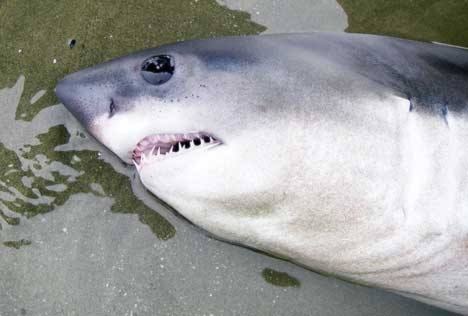Sharks have been around for an estimated 200 million years, and evolution has changed them little. “They got the right body form for survival way back,” says Jenn Yakimishyn, a marine biologist with Pacific Rim National Park Reserve.
“They were the perfect fish way back then and they haven’t had to change that much. They are a top predator in the ecosystem, which is an important role that they play. Every animal plays a role: if you move something like a large predator out of the ecosystem, there will be a cascading effect on the entire food web,” she adds.
Given a bad rep through frightening depictions by popular media, sharks are coming to the attention of the public as a beautiful part of our marine ecosystem that is increasingly at threat. Yakimishyn, has been in love with sharks every since she can remember.
“Sharks have always fascinated me since I was a little girl,” she says.
“I lived on the prairies and they are always my favourite group of fish. I have never been fearful. They are an amazing creature with so much diversity.”
Barkley Sound boasts a diversity of 12-13 shark species, some being migratory. Common species include blue shark, blunt nosed six gill, broad nosed seven gill, great white shark, salmon shark, spiny dogfish and the tope shark.
Less common are the brown cat shark, and other deep water species such as the; Pacific angel shark, Pacific sleeper shark, short-finned maco shark and thin tailed thresher shark.
Sharks are increasingly threatened by fishing effects and by-catch, which is when fishing gear inadvertently catches species other than their targeted species, like salmon or halibut, for example.
Sharks are also a long-lived species, making them susceptible to over-fishing because they don’t reproduce as often. In fact some species have very long gestational periods, like the spiny dogfish, which carries its offspring for 18-24 months.
“It is pretty remarkable. Dogfish live to be up to 100 years old—that is really amazing,” says Yakimishyn.
“They produce very few young and give birth to live young for the most part, with a very long gestation period ranging a year to up to three years.”
One species of concern is the six gill shark. “Six gill sharks are listed as special concern under the Species at Risk Act, and we have been tagging six gills to figure out where they are going in the Strait of Georgia,” says Yakimishyn. “Genetic samples are kept from ones that are caught and washed up, and we use the opportunity to gather more information.”
After a full necropsy by DFO staff on the recently washed up female six gill in the Alberni Inlet, it has been concluded that the young female entered shallow waters to pup, and got beached.
Parks Canada has been doing work with others on the West Coast to study and better understand this top predator in the food chain. “As for Parks Canada’s role, we collect many reports of shark sightings and beachings and go out in response to them,” says Yakimishyn.
“We work and collaborate with DFO scientists and people on the water to make connections between some of the research at DFO to here at the park.”
Sharks are challenging to study as they are highly migratory, moving around a lot as well as being shy and illusive. “You don’t see them very often,” says Yakimishyn, “A lot are deeper water species and don’t come up to the shallow waters very often.”
So what can we do to help our local sharks to ensure they continue to be healthy? “If you see six gills, tope sharks or basking sharks, call the DFO hotline immediately,” requests Yakimishyn
“They have a toll free hotline at: 1-877-50-SHARK. If you see any large shark, report it immediately.”
Part of the recovery plan for the endangered basking shark is gathering more information through satellite tags. DFO is working to find out where basking sharks are going and how much populations mix within the Pacific Ocean as not much is currently known about this population.
“From a fishing point of view, please use best practices,” Yakimishyn says.
“Don’t gaff (sharks) to get them off the hook, keep them in the water, and minimize the damage.
“They don’t have a swim bladder when pulled up from a deep depth because they use their liver for buoyancy. Also, don’t bring them up on the boat, they can be released and they can be just fine.”
Yakimishyn also recommends taking the time to learn more and appreciate these beautiful animals.
A great website with interesting info about sharks can be found at http://bcsharkreports.blogspot.com/
To learn more about what you can do to support species and ecosystem health to make the west coast the best coast, visit www.tsawalk.ca.
